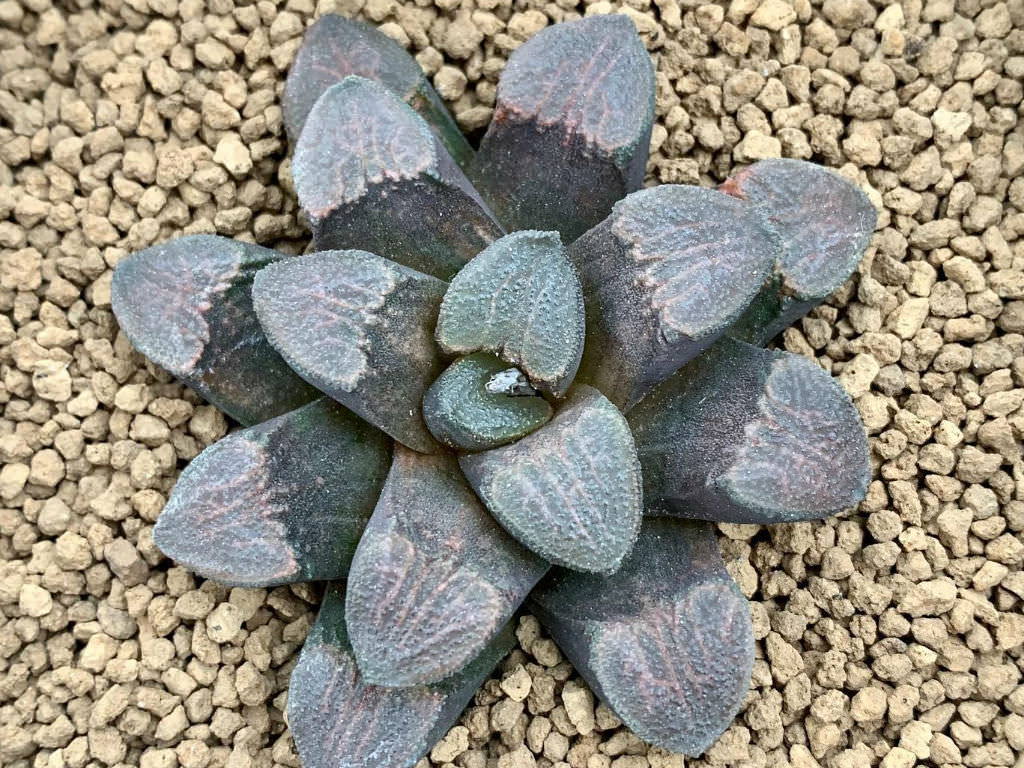Scientific Name
Haworthiopsis bruynsii (M.B.Bayer) G.D.Rowley
Common Name(s)
Pad Haworthia
Synonym(s)
Haworthia bruynsii, Haworthia retusa var. bruynsii
Scientific Classification
Family: Asphodelaceae
Subfamily: Asphodeloideae
Tribe: Aloeae
Genus: Haworthiopsis
Origin
This species is native to South Africa (restricted to a small area in the Eastern Cape).
Description
Haworthiopsis bruynsii, formerly known as Haworthia bruynsii, is a small, slow-growing succulent that forms a stemless, usually solitary rosette of green to brownish, highly truncated leaves. The rosettes grow up to 2.4 inches (6 cm) in diameter and have only 5 to 10 leaves. In habitat, the rosettes grow sunken beneath the ground with only the translucent tops of the leaves exposed. The leaf tops are flat, usually very rough or occasionally smooth. Flowers are white with green to brownish veins and appear on a slender, unbranched inflorescence in spring and summer.
This species is very similar to Retuse Haworthias, but because of the flower (long and wiry peduncle and the six-sided florets at the base) is a member of the genus Haworthiopsis. It seems to be a case of parallel evolution in a similar environment.
Etymology
The specific epithet "bruynsii" honors Peter Vincent Bruyns (1957-), a South African mathematician and botanist.

How to Grow and Care for Haworthiopsis bruynsii
Light: H. bruynsii thrives in semi-shaded positions. Brighter light conditions are needed to bring out the leaf coloration. Any window in your home or office will likely be an appropriate setting for this succulent.
Soil: Use a commercial potting soil specially formulated for succulents or make your own well-draining potting mix.
Hardiness: This plant likes warmer temperatures in summer but cooler in winter. H. bruynsi can withstand temperatures as low as 30 to 50 °F (-1.1 to 10 °C), USDA hardiness zones 10a to 11b.
Watering: In spring and fall, when the growth is most active, water H. bruynsi thoroughly, then wait until the top of the soil dries out before watering again. Water your plant less during the winter when its growth slows down significantly. During the hottest summer months, when this plant is mostly dormant, water just enough to keep the leaves from shriveling.
Fertilizing: H. bruynsi is a slow-growing plant that does not require much fertilizer. However, for optimum growth, fertilization is a good idea. Feed only with a dilute fertilizer and only during the active growing season. Avoid summer fertilizing as this succulent is in a 6 to 8 weeks rest period.
Repotting: When the plant has outgrown its container, repot it into a new, slightly larger pot with fresh soil in the spring or early summer.
Propagation: Since it rarely offsets, H. bruynsi is usually propagated by seed. Sow the seeds in spring.
Learn more at How to Grow and Care for Haworthiopsis.
Toxicity of Haworthiopsis bruynsii
H. bruynsii is considered non-toxic to humans and animals.
Links
- Back to genus Haworthiopsis
- Succupedia: Browse succulents by Scientific Name, Common Name, Genus, Family, USDA Hardiness Zone, Origin, or cacti by Genus
Photo Gallery
Click on a photo to see a larger version.



